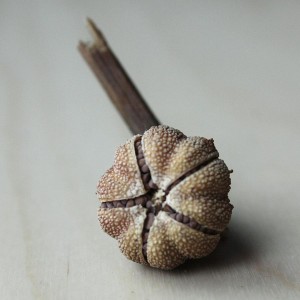While my last post was dedicated to an easy seed propagation project, this one details a couple that were a little more labor-intensive. Still not hard, just a little bit more work to pull off.

I’ve posted about my pitcher plants a few times before–Sarracenia species from the American South and some hybrids–and this is the first year I’ve tried sowing my own seed. All eight species (or nine, or ten or eleven, depending on the expert you listen to) are inter-fertile, and hybrids between all of them are possible and have been made at one time or another. The hybrids, too, are generally fertile, and you can go crazy with the genetic possibilities.

For creative sorts you can arrange garden plants in interesting ways, but with this genus you could also design the very plants that you grow. If you live in the heart of pitcher plant country, this might be a problem. Bees could carry pollen from your hybrid plants to nearby native species and create some new unnatural hybrids. But the genus never crossed to this side of the Mississippi River so Californians can play Doctor Frankenstein all they want without worrying about messing with the native population beyond our castle walls.

So…I began in the spring making some hybrids, and the pods began to ripen in August, with the last pods just finishing up ripening right about now.

The seeds require a cool, damp period in order to germinate. I emptied the pods and put the seed in a plastic bag with a few strands of moist chopped sphagnum moss, one bag for each cross. And into the fridge they went for four weeks.
After this period of cold stratification I sowed the seed on the surface of chopped sphagnum moss which I’d layered on the top of post filled 50/50 with a sand/peat mixture.
Next, I put the pots into a clear plastic box, poured in half an inch of standing rainwater, closed the lid, and put them near a window that faces south-southeast. If everything goes well–and it looks like it did–the seedlings begin to emerge in two to four weeks. Warmish weather is best, though you don’t have to be too fanatical. This batch experienced the recent 90- to 100-degree days as well as many cooler days in the 60s. As long as the seed think it’s spring, they’ll begin to germinate.
That’s pretty much it. Some people place the seedlings under constant bright lights and 70-plus degree temperatures for up to three years to speed them up to maturity. I’m hoping that bright daylight in a warmish interior spot will give them enough of a boost that I don’t have to resort to the equivalent of putting the plants on steroids.

And here you see the reason why people might try to accelerate growth. These are year-old seedlings from a cross by Brooks Garcia that I sowed a year ago, thinking I’d practice on someone else’s cross before attempting my own. I grew these in my unheated greenhouse which has fairly low, less-than-ideal lighting conditions. They did get some bottom heat during the coldest months of the year.

The other carnivorous plants I’m propagating this fall are of this Mediterranean-region species, Drosophyllum lusitanicum. While virtually all carnivorous plants are creatures of swamps and bogs, this one is unique in that it comes from fairly dry areas with be limited summer rainfall. Unlike the preceding sarracenia bog plants, this species could actually thrive in California’s wet-winter, dry-summer climate without too much additional life support.
Its common name is “Dewy Pine” because the leaves have little tentacles tipped with sticky bug-catching fluid that looks like dew. But Barry Rice mentions a much cooler moniker: Its Portuguese name translates into “Slobbering Pine.”
This plant and the preceding Sarracenia do catch insects. It’s a contradiction I’m trying to come to terms with. I plant a lot of California native plants, which provide nectar and other food for all sorts of winged and crawling creatures. And then I have these little monsters that actively trap and consume them. Call me a man of contradictions. In the end I hope I’m doing lots more good than bad.
I only know of one seller who ships Drosophyllum so you pretty much have to grow your own from seed if you want one. (I got my seed from the seed bank of the International Carnivorous Plant Society.) The little black seeds have a hard coat that slows down germination. If you have some 220-grit sandpaper around that’s not a problem. Just lightly–and I mean lightly–rub the seed between two sheets of the sandpaper until a patch of the black seed coat is worn away to reveal the white layer underneath. Then pop them on top of the same mixture you’d use for germinating Sarracenia and keep the mix moist with good-quality water. Germination for me was about two to six weeks, no cold stratification necessary.
There you have it. With both of these kinds of plants it was a little more work than my last post growing bladderods from seed. But really, it isn’t that hard if you’re patient.


